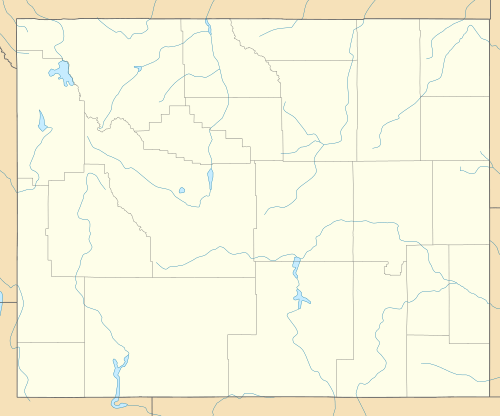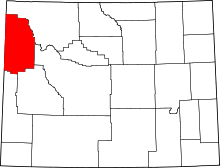Wilson, Wyoming
| Wilson, Wyoming | |
|---|---|
| CDP | |
 Wilson, Wyoming Location of Wilson, Wyoming | |
| Coordinates: 43°29′11″N 110°52′45″W / 43.48639°N 110.87917°WCoordinates: 43°29′11″N 110°52′45″W / 43.48639°N 110.87917°W | |
| Country | United States |
| State | Wyoming |
| County | Teton |
| Area | |
| • Total | 23.44 sq mi (60.7 km2) |
| • Land | 22.96 sq mi (59.5 km2) |
| • Water | 0.48 sq mi (1.2 km2) |
| Elevation | 6,148 ft (1,874 m) |
| Population (2010)[1] | |
| • Total | 1,482 |
| • Density | 63/sq mi (24/km2) |
| Time zone | Mountain (MST) (UTC-7) |
| • Summer (DST) | MDT (UTC-6) |
| ZIP code | 83014 |
| Area code(s) | 307 |
| FIPS code | 56-83765[2] |
| GNIS feature ID | 1604543[3] |
Wilson is a census-designated place (CDP) in Teton County, Wyoming, United States. The population was 1,482 at the 2010 census, up from 1,294 in 2000. It is part of the Jackson, WY–ID Micropolitan Statistical Area.
Wilson was pioneered in 1889 by Elijah Nicholas Wilson, known for having lived with the Shoshone Indian tribe as a boy in the 1850s. He later wrote a book[4] about his experiences, including his time as a rider for the Pony Express. The town was later named in his honor.[5] It sits at the base of Teton Pass, just northwest of Jackson, on State Highway 22.
Geography
Wilson is located at 43°29′11″N 110°52′45″W / 43.48639°N 110.87917°W (43.4863, -110.8793).[6] at an elevation of 6,148 feet (1,874 m) above sea level.
According to the United States Census Bureau, the CDP has a total area of 23.44 square miles (60.7 km2), of which, 22.96 square miles (59.5 km2) of it is land and 0.5 square miles (1.3 km2) of it (2.05%) is water.
Demographics
As of the census[2] of 2000, there were 1,294 people, 563 households, and 305 families residing in the CDP. The population density was 56.0 people per square mile (21.6/km²). There were 706 housing units at an average density of 30.5/sq mi (11.8/km²). The racial makeup of the CDP was 97.68% White, 0.08% African American, 0.15% Native American, 0.46% Asian, 0.54% from other races, and 1.08% from two or more races. Hispanic or Latino of any race were 1.00% of the population.
There were 563 households out of which 25.2% had children under the age of 18 living with them, 47.6% were married couples living together, 3.7% had a female householder with no husband present, and 45.8% were non-families. 28.6% of all households were made up of individuals and 2.7% had someone living alone who was 65 years of age or older. The average household size was 2.27 and the average family size was 2.86.
In the CDP, the population was spread out with 20.9% under the age of 18, 4.3% from 18 to 24, 39.1% from 25 to 44, 28.3% from 45 to 64, and 7.4% who were 65 years of age or older. The median age was 37 years. For every 100 females there were 117.1 males. For every 100 females age 18 and over, there were 120.0 males.
The median income for a household in the CDP was $69,327, and the median income for a family was $93,354. Males had a median income of $30,455 versus $61,635 for females. The per capita income for the CDP was $65,489. None of the families and 6.4% of the population were living below the poverty line, including no under eighteen and none of those over 64.
Education
Public education in the community of Teton Village is provided by Teton County School District #1. Schools serving the community include Wilson Elementary School (grades K-5), Jackson Hole Middle School (grades 6-8), and Jackson Hole High School (grades 9-12).
Notable residents
- Alan Hirschfield – film studio executive, CEO of Columbia Pictures (1973–1978), chairman of 20th Century Fox (1982–1986)[7]
Other
The commercial area is centered mainly around the Fish Creek plaza. Community events take place in the Owen Bircher park, which includes an ice rink and horse corrals.
References
- ↑ "2010 City Population and Housing Occupancy Status". U.S. Census Bureau. Retrieved July 13, 2012.
- 1 2 "American FactFinder". United States Census Bureau. Retrieved 2008-01-31.
- ↑ "US Board on Geographic Names". United States Geological Survey. 2007-10-25. Retrieved 2008-01-31.
- ↑ Elijah Nicholas Wilson (1919). The White Indian Boy: The Story of Uncle Nick Among the Shoshones. World Book Company. pp. 3–. Retrieved 4 April 2013.
- ↑ Elijah Nicholas Wilson (1919). The White Indian Boy: The Story of Uncle Nick Among the Shoshones. World Book Company. pp. 5–. Retrieved 4 April 2013.
- ↑ "US Gazetteer files: 2010, 2000, and 1990". United States Census Bureau. 2011-02-12. Retrieved 2011-04-23.
- ↑ Stedman, Alex (2015-01-16). "Alan Hirschfield, Former Columbia Chief Exec, Dies at 79". Variety. Retrieved 2015-02-08.
